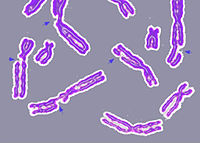
Photo from wikipedia
The response to DNA damage intersects with many other physiological processes in the cell, such as DNA replication, chromatin remodeling, and the cell cycle. Certain damaging lesions, such as UV-induced… Click to show full abstract
The response to DNA damage intersects with many other physiological processes in the cell, such as DNA replication, chromatin remodeling, and the cell cycle. Certain damaging lesions, such as UV-induced pyrimidine dimers, also strongly block RNA polymerases, necessitating the coordination of the repair mechanism with remodeling of the elongating transcriptional machinery, in a process called transcription-coupled nucleotide excision repair (TC-NER). This pathway is typically not thought to be engaged with smaller lesions such as base alkylation. However, recent work has uncovered the potential for shared molecular components between the cellular response to alkylation and UV damage. Here, we review our current understanding of the alkylation damage response and its impacts on RNA biogenesis. We give particular attention to the Activating Signal Cointegrator Complex (ASCC), which plays important roles in the transcriptional response during UV damage as well as alkylation damage reversal, and intersects with trichothiodystrophy, an inherited disease associated with TC-NER.
Journal Title: DNA repair
Year Published: 2019
Link to full text (if available)
Share on Social Media: Sign Up to like & get
recommendations!